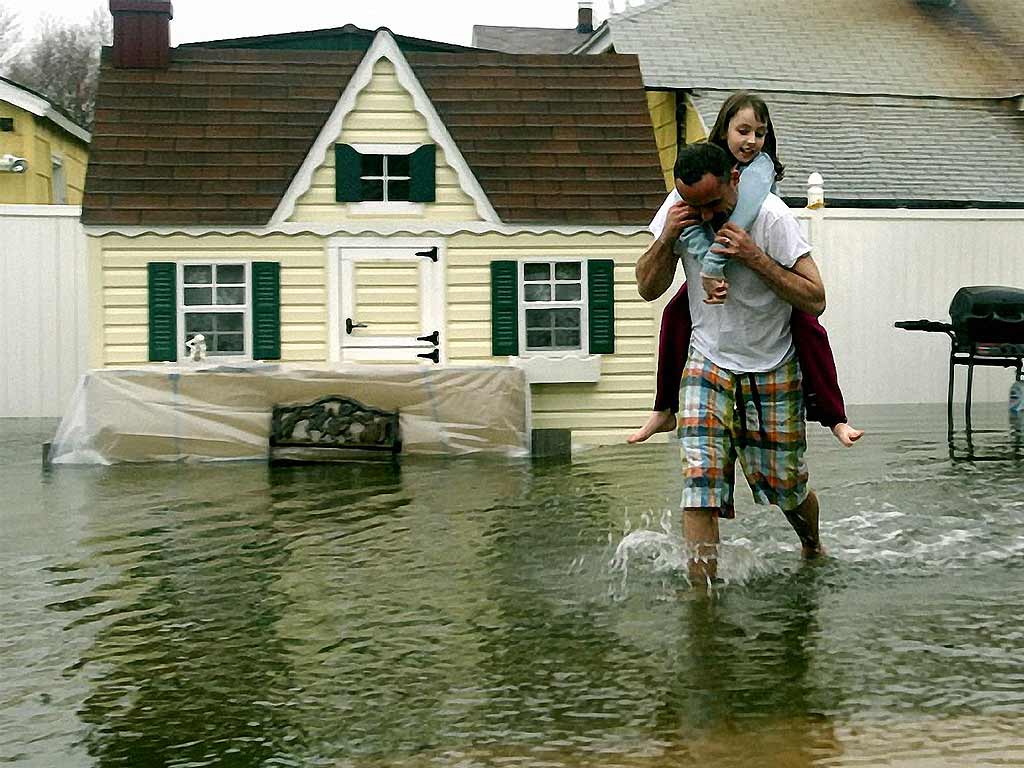Originally published: August 11, 2009 9:39 PM, Updated: August 12, 2009 6:03 AM
By BY TOM INCANTALUPO tom.incantalupo@newsday.com
More than 25,000 Long Island homeowners may have to buy flood insurance that costs up to $2,000 because their homes are in newly designated flood-prone areas in federal maps that go into effect next month.

Photo credit: Newsday Photo, 2007 / Thomas A. Ferrara | Tom Cormack carries a neighbor, Shannon McGhean, 9, through water that flooded his backyard in Freeport. (April 2007)
However, the homeowners can reduce the cost of a flood policy by buying coverage before Sept. 11 in Nassau and Sept. 25 in Suffolk — when the new Federal Emergency Management Agency maps become official.
For those who meet the deadlines, the rates should be less than $400 per year, which buys $250,000 in coverage for the house and $100,000 for its contents, said Denis Miller, a local expert on the subject and owner of Denis A. Miller Insurance in Long Beach.
Congress ordered FEMA to redraw the maps — and about 25,000 homes in Nassau and 325 in Suffolk have been reclassified into floodplain areas.
Most of the homes moved into flood areas are in southern portions of Nassau County, and insurance brokers and government officials are trying to get the word out to homeowners who have not been notified by their lenders.
Although the maps add 325 homes into flood-prone areas, many more Suffolk homes — about 4,500 — were taken out of such areas when the maps were redrawn.
Long Beach City officials have mailed a reminder to residents about the changes and suggested that they act by Tuesday because there is a 30-day waiting period before coverage kicks in. But residents can lock in rates through Sept. 11. Homeowners who have flood insurance don’t need to do anything, even if their homes are in a new flood zone.
“If they already have flood insurance,” there’s no problem,” said Long Beach City spokeswoman Mary Giambalvo.
Here’s what you need to know:
Why the new maps?
Congress ordered FEMA to redraw its maps, based on updated topographical information on the “flood plain” — the normally dry areas where water will accumulate or flow during a 100-year flood event, such as that hurricane that ravaged portions of Long Island in September 1938.
What are the affected areas?
Nassau areas affected include the remainder of the City of Long Beach not already in the flood zone, most of North Woodmere and parts of Oceanside, Island Park, Valley Stream and other communities, Miller said. In Suffolk, the new areas include parts of the villages of Amityville, Asharoken and Sagaponack and other portions of Babylon and Huntington towns.
What can homeowners do?
Take advantage of the “grandfathering” provisions of the federal regulations covering the National Flood Insurance Program.
To spare homeowners from the shock of rates up to $2,000 a year, the rules permit homeowners in the new areas to purchase insurance until the new maps become effective at the old, lower rate classifications for areas that are not deemed flood prone.
Those lower rates stay in effect even after the new maps become effective. And if those homes change hands, the policies can be transferred to the new homeowner at the same rate, said James J. Callahan III, Nassau’s commissioner of emergency management.
Buyers of the homes without flood insurance face premiums of $1,500 to more than $2,000 a year just for that portion of their homeowner’s coverage, said Miller. He said grandfathering has been controversial because, in effect, the grandfathered homeowners are subsidized by those paying full price for the same flood insurance.
What is the National Flood Insurance Program?
FEMA has an arrangement with private insurance companies to sell and service flood insurance policies. A list of private insurance companies that sell and service these policies is available at fema.gov.
Under the program, FEMA said it provides the money to pay the claims, from premiums, not from tax dollars. The program was set up to reduce the taxpayer funding needed to provide federal disaster assistance.
Up to $250,000 coverage is available for homes, plus $100,000 for their contents. Policies also are available for condo owners and renters.
Who should buy the flood insurance in the new areas?
- Homeowners who do not have flood insurance — and are required by a lender to have flood insurance.
- Homeowners who do not now have flood insurance, are not required by a lender to have it but are considering selling their homes. “If there are two identical houses, one grandfathered and the other not, which one are you going to take?” asked Callahan.
- Homeowners without flood insurance who plan to refinance their homes or take home equity lines of credit. The lender probably will demand flood coverage.
How do I shop for insurance?
Since FEMA provides the coverage, rates will be the same regardless of carriers, according to Miller and the agency’s Web site.
Homeowners with mortgages should find out from their lender what level of coverage the homes require. Generally, $250,000 for the home is standard.
To reduce rates, consider a deductible higher than the usual $500 on these policies.
Homeowners should ask insurance agents for lower rates available if they obtain an “elevation certificate” from a surveyor documenting that your property is relatively high and less flood prone.
Click here to download the PDF flood maps for Nassau (1.7 MB)
Click here to download the PDF flood maps for Suffolk (5.5 MB)
